Analysis of UK Macroeconomic Indicators and Trade Performance
VerifiedAdded on 2023/06/04
|8
|1642
|163
Report
AI Summary
This report provides an analysis of the UK's macroeconomic indicators, focusing on GDP, inflation, and unemployment rates, along with an examination of the UK's trade performance and balance of payments. The report delves into the significance of each indicator, offering data-driven insights into the UK's economic health and trends. It explores the factors influencing GDP, the causes and implications of inflation, and the dynamics of unemployment. Furthermore, the report investigates the UK's balance of payments, shedding light on its trade deficits and surpluses. By examining these key macroeconomic gauges, the report offers a comprehensive overview of the UK's economic landscape and its position within the global economy, supported by relevant data and analysis of economic concepts and trade policies. The report uses data from 2008-2018 to show trends in GDP, inflation, and unemployment.
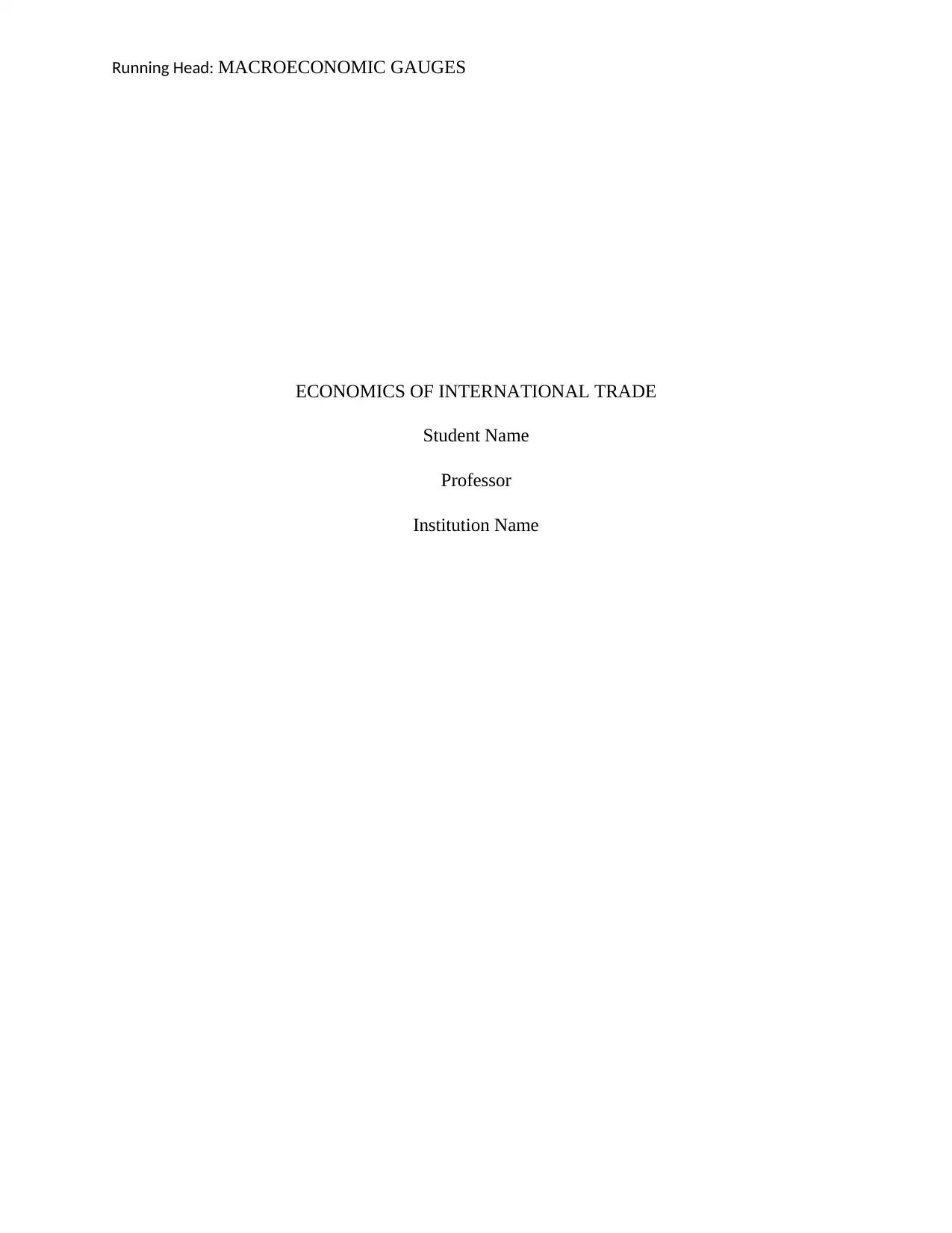
Running Head: MACROECONOMIC GAUGES
ECONOMICS OF INTERNATIONAL TRADE
Student Name
Professor
Institution Name
ECONOMICS OF INTERNATIONAL TRADE
Student Name
Professor
Institution Name
Paraphrase This Document
Need a fresh take? Get an instant paraphrase of this document with our AI Paraphraser
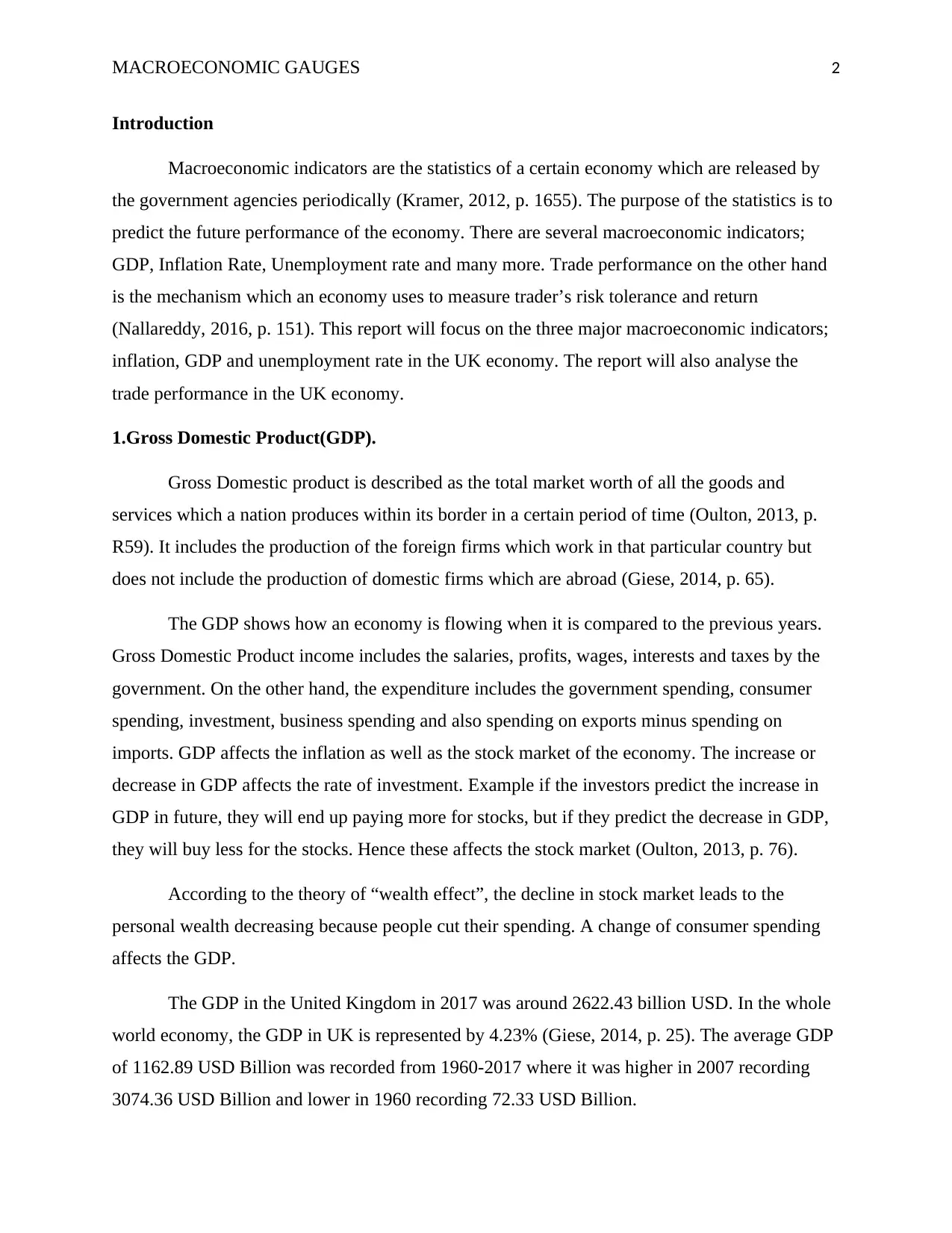
MACROECONOMIC GAUGES 2
Introduction
Macroeconomic indicators are the statistics of a certain economy which are released by
the government agencies periodically (Kramer, 2012, p. 1655). The purpose of the statistics is to
predict the future performance of the economy. There are several macroeconomic indicators;
GDP, Inflation Rate, Unemployment rate and many more. Trade performance on the other hand
is the mechanism which an economy uses to measure trader’s risk tolerance and return
(Nallareddy, 2016, p. 151). This report will focus on the three major macroeconomic indicators;
inflation, GDP and unemployment rate in the UK economy. The report will also analyse the
trade performance in the UK economy.
1.Gross Domestic Product(GDP).
Gross Domestic product is described as the total market worth of all the goods and
services which a nation produces within its border in a certain period of time (Oulton, 2013, p.
R59). It includes the production of the foreign firms which work in that particular country but
does not include the production of domestic firms which are abroad (Giese, 2014, p. 65).
The GDP shows how an economy is flowing when it is compared to the previous years.
Gross Domestic Product income includes the salaries, profits, wages, interests and taxes by the
government. On the other hand, the expenditure includes the government spending, consumer
spending, investment, business spending and also spending on exports minus spending on
imports. GDP affects the inflation as well as the stock market of the economy. The increase or
decrease in GDP affects the rate of investment. Example if the investors predict the increase in
GDP in future, they will end up paying more for stocks, but if they predict the decrease in GDP,
they will buy less for the stocks. Hence these affects the stock market (Oulton, 2013, p. 76).
According to the theory of “wealth effect”, the decline in stock market leads to the
personal wealth decreasing because people cut their spending. A change of consumer spending
affects the GDP.
The GDP in the United Kingdom in 2017 was around 2622.43 billion USD. In the whole
world economy, the GDP in UK is represented by 4.23% (Giese, 2014, p. 25). The average GDP
of 1162.89 USD Billion was recorded from 1960-2017 where it was higher in 2007 recording
3074.36 USD Billion and lower in 1960 recording 72.33 USD Billion.
Introduction
Macroeconomic indicators are the statistics of a certain economy which are released by
the government agencies periodically (Kramer, 2012, p. 1655). The purpose of the statistics is to
predict the future performance of the economy. There are several macroeconomic indicators;
GDP, Inflation Rate, Unemployment rate and many more. Trade performance on the other hand
is the mechanism which an economy uses to measure trader’s risk tolerance and return
(Nallareddy, 2016, p. 151). This report will focus on the three major macroeconomic indicators;
inflation, GDP and unemployment rate in the UK economy. The report will also analyse the
trade performance in the UK economy.
1.Gross Domestic Product(GDP).
Gross Domestic product is described as the total market worth of all the goods and
services which a nation produces within its border in a certain period of time (Oulton, 2013, p.
R59). It includes the production of the foreign firms which work in that particular country but
does not include the production of domestic firms which are abroad (Giese, 2014, p. 65).
The GDP shows how an economy is flowing when it is compared to the previous years.
Gross Domestic Product income includes the salaries, profits, wages, interests and taxes by the
government. On the other hand, the expenditure includes the government spending, consumer
spending, investment, business spending and also spending on exports minus spending on
imports. GDP affects the inflation as well as the stock market of the economy. The increase or
decrease in GDP affects the rate of investment. Example if the investors predict the increase in
GDP in future, they will end up paying more for stocks, but if they predict the decrease in GDP,
they will buy less for the stocks. Hence these affects the stock market (Oulton, 2013, p. 76).
According to the theory of “wealth effect”, the decline in stock market leads to the
personal wealth decreasing because people cut their spending. A change of consumer spending
affects the GDP.
The GDP in the United Kingdom in 2017 was around 2622.43 billion USD. In the whole
world economy, the GDP in UK is represented by 4.23% (Giese, 2014, p. 25). The average GDP
of 1162.89 USD Billion was recorded from 1960-2017 where it was higher in 2007 recording
3074.36 USD Billion and lower in 1960 recording 72.33 USD Billion.
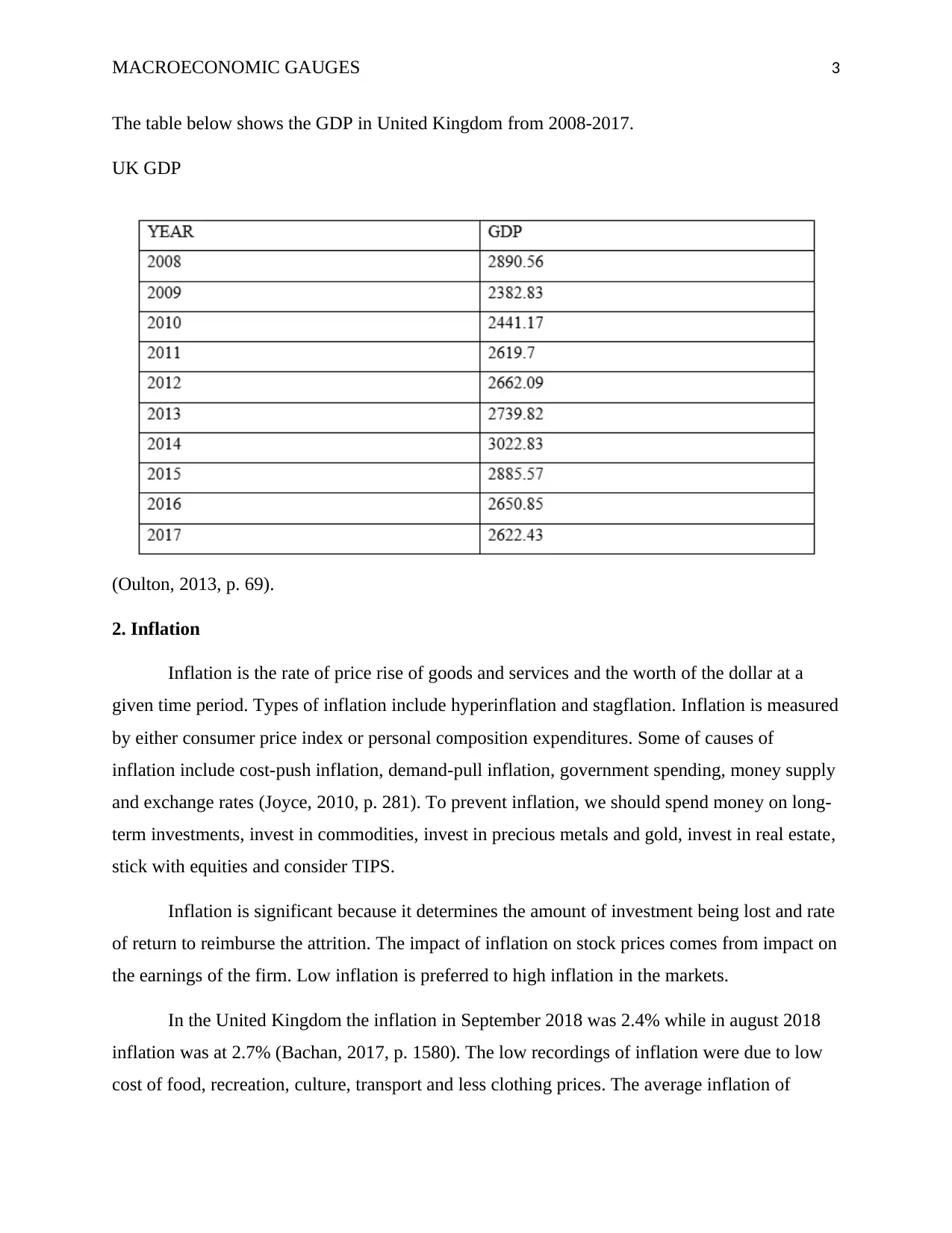
MACROECONOMIC GAUGES 3
The table below shows the GDP in United Kingdom from 2008-2017.
UK GDP
(Oulton, 2013, p. 69).
2. Inflation
Inflation is the rate of price rise of goods and services and the worth of the dollar at a
given time period. Types of inflation include hyperinflation and stagflation. Inflation is measured
by either consumer price index or personal composition expenditures. Some of causes of
inflation include cost-push inflation, demand-pull inflation, government spending, money supply
and exchange rates (Joyce, 2010, p. 281). To prevent inflation, we should spend money on long-
term investments, invest in commodities, invest in precious metals and gold, invest in real estate,
stick with equities and consider TIPS.
Inflation is significant because it determines the amount of investment being lost and rate
of return to reimburse the attrition. The impact of inflation on stock prices comes from impact on
the earnings of the firm. Low inflation is preferred to high inflation in the markets.
In the United Kingdom the inflation in September 2018 was 2.4% while in august 2018
inflation was at 2.7% (Bachan, 2017, p. 1580). The low recordings of inflation were due to low
cost of food, recreation, culture, transport and less clothing prices. The average inflation of
The table below shows the GDP in United Kingdom from 2008-2017.
UK GDP
(Oulton, 2013, p. 69).
2. Inflation
Inflation is the rate of price rise of goods and services and the worth of the dollar at a
given time period. Types of inflation include hyperinflation and stagflation. Inflation is measured
by either consumer price index or personal composition expenditures. Some of causes of
inflation include cost-push inflation, demand-pull inflation, government spending, money supply
and exchange rates (Joyce, 2010, p. 281). To prevent inflation, we should spend money on long-
term investments, invest in commodities, invest in precious metals and gold, invest in real estate,
stick with equities and consider TIPS.
Inflation is significant because it determines the amount of investment being lost and rate
of return to reimburse the attrition. The impact of inflation on stock prices comes from impact on
the earnings of the firm. Low inflation is preferred to high inflation in the markets.
In the United Kingdom the inflation in September 2018 was 2.4% while in august 2018
inflation was at 2.7% (Bachan, 2017, p. 1580). The low recordings of inflation were due to low
cost of food, recreation, culture, transport and less clothing prices. The average inflation of
⊘ This is a preview!⊘
Do you want full access?
Subscribe today to unlock all pages.

Trusted by 1+ million students worldwide
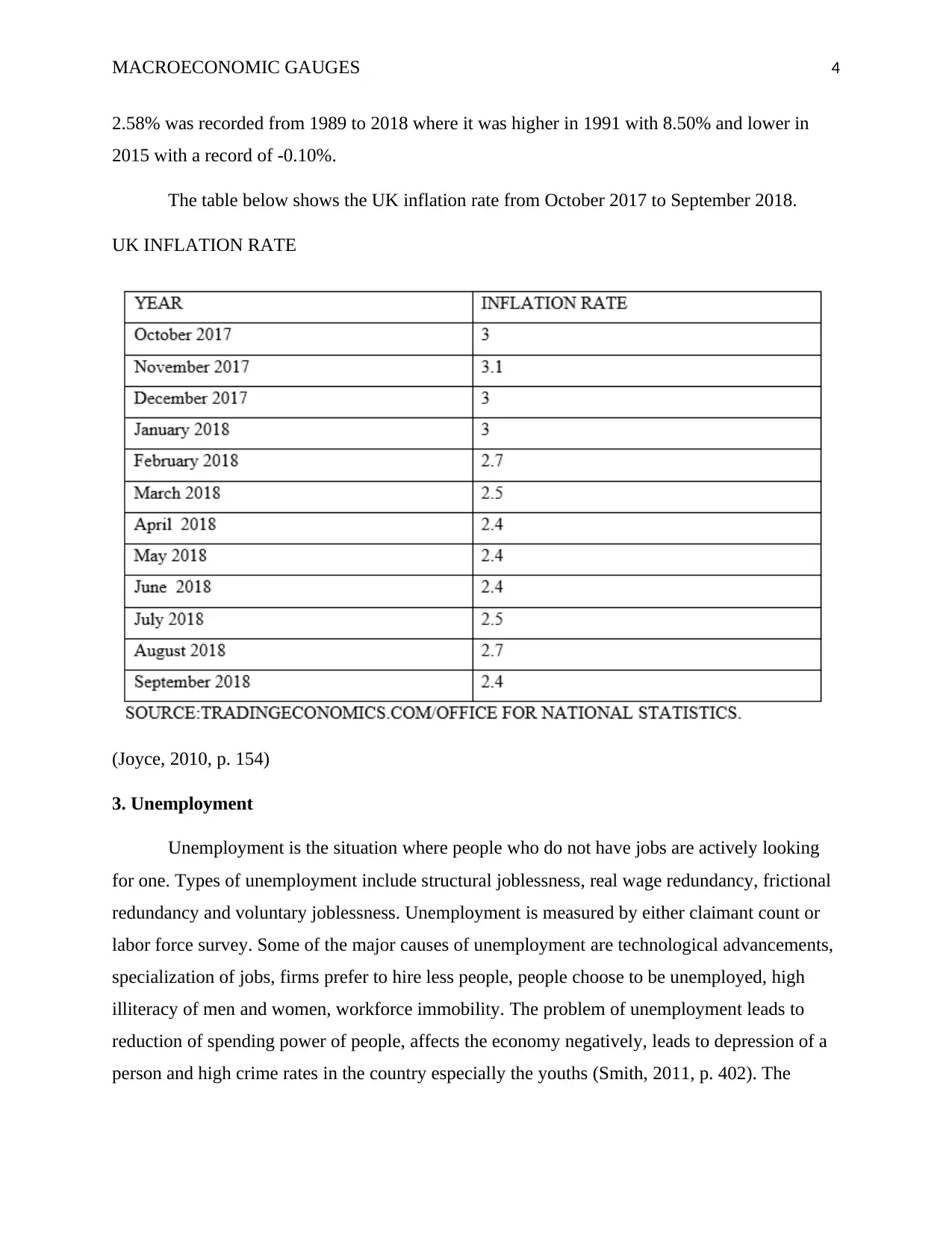
MACROECONOMIC GAUGES 4
2.58% was recorded from 1989 to 2018 where it was higher in 1991 with 8.50% and lower in
2015 with a record of -0.10%.
The table below shows the UK inflation rate from October 2017 to September 2018.
UK INFLATION RATE
(Joyce, 2010, p. 154)
3. Unemployment
Unemployment is the situation where people who do not have jobs are actively looking
for one. Types of unemployment include structural joblessness, real wage redundancy, frictional
redundancy and voluntary joblessness. Unemployment is measured by either claimant count or
labor force survey. Some of the major causes of unemployment are technological advancements,
specialization of jobs, firms prefer to hire less people, people choose to be unemployed, high
illiteracy of men and women, workforce immobility. The problem of unemployment leads to
reduction of spending power of people, affects the economy negatively, leads to depression of a
person and high crime rates in the country especially the youths (Smith, 2011, p. 402). The
2.58% was recorded from 1989 to 2018 where it was higher in 1991 with 8.50% and lower in
2015 with a record of -0.10%.
The table below shows the UK inflation rate from October 2017 to September 2018.
UK INFLATION RATE
(Joyce, 2010, p. 154)
3. Unemployment
Unemployment is the situation where people who do not have jobs are actively looking
for one. Types of unemployment include structural joblessness, real wage redundancy, frictional
redundancy and voluntary joblessness. Unemployment is measured by either claimant count or
labor force survey. Some of the major causes of unemployment are technological advancements,
specialization of jobs, firms prefer to hire less people, people choose to be unemployed, high
illiteracy of men and women, workforce immobility. The problem of unemployment leads to
reduction of spending power of people, affects the economy negatively, leads to depression of a
person and high crime rates in the country especially the youths (Smith, 2011, p. 402). The
Paraphrase This Document
Need a fresh take? Get an instant paraphrase of this document with our AI Paraphraser
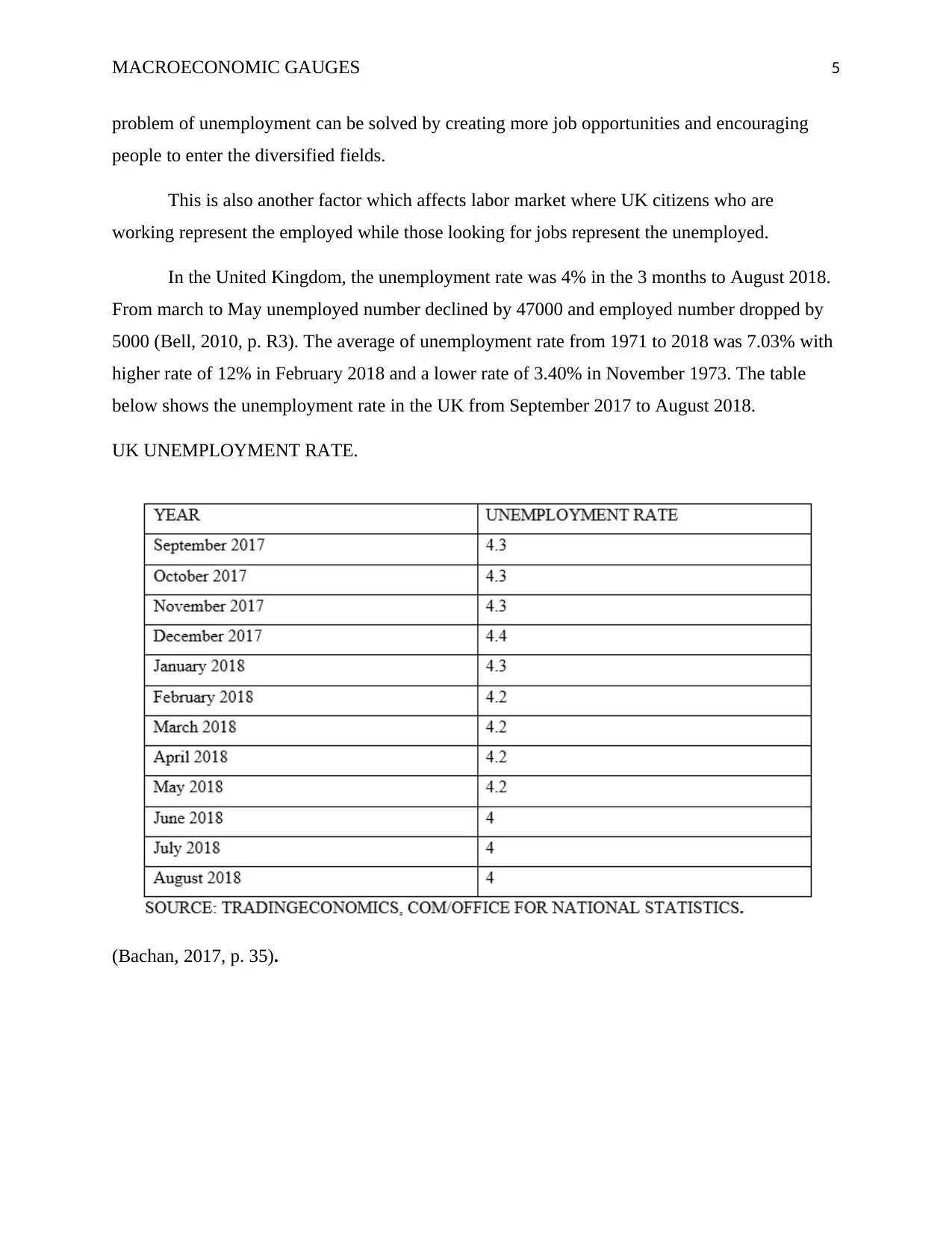
MACROECONOMIC GAUGES 5
problem of unemployment can be solved by creating more job opportunities and encouraging
people to enter the diversified fields.
This is also another factor which affects labor market where UK citizens who are
working represent the employed while those looking for jobs represent the unemployed.
In the United Kingdom, the unemployment rate was 4% in the 3 months to August 2018.
From march to May unemployed number declined by 47000 and employed number dropped by
5000 (Bell, 2010, p. R3). The average of unemployment rate from 1971 to 2018 was 7.03% with
higher rate of 12% in February 2018 and a lower rate of 3.40% in November 1973. The table
below shows the unemployment rate in the UK from September 2017 to August 2018.
UK UNEMPLOYMENT RATE.
(Bachan, 2017, p. 35).
problem of unemployment can be solved by creating more job opportunities and encouraging
people to enter the diversified fields.
This is also another factor which affects labor market where UK citizens who are
working represent the employed while those looking for jobs represent the unemployed.
In the United Kingdom, the unemployment rate was 4% in the 3 months to August 2018.
From march to May unemployed number declined by 47000 and employed number dropped by
5000 (Bell, 2010, p. R3). The average of unemployment rate from 1971 to 2018 was 7.03% with
higher rate of 12% in February 2018 and a lower rate of 3.40% in November 1973. The table
below shows the unemployment rate in the UK from September 2017 to August 2018.
UK UNEMPLOYMENT RATE.
(Bachan, 2017, p. 35).
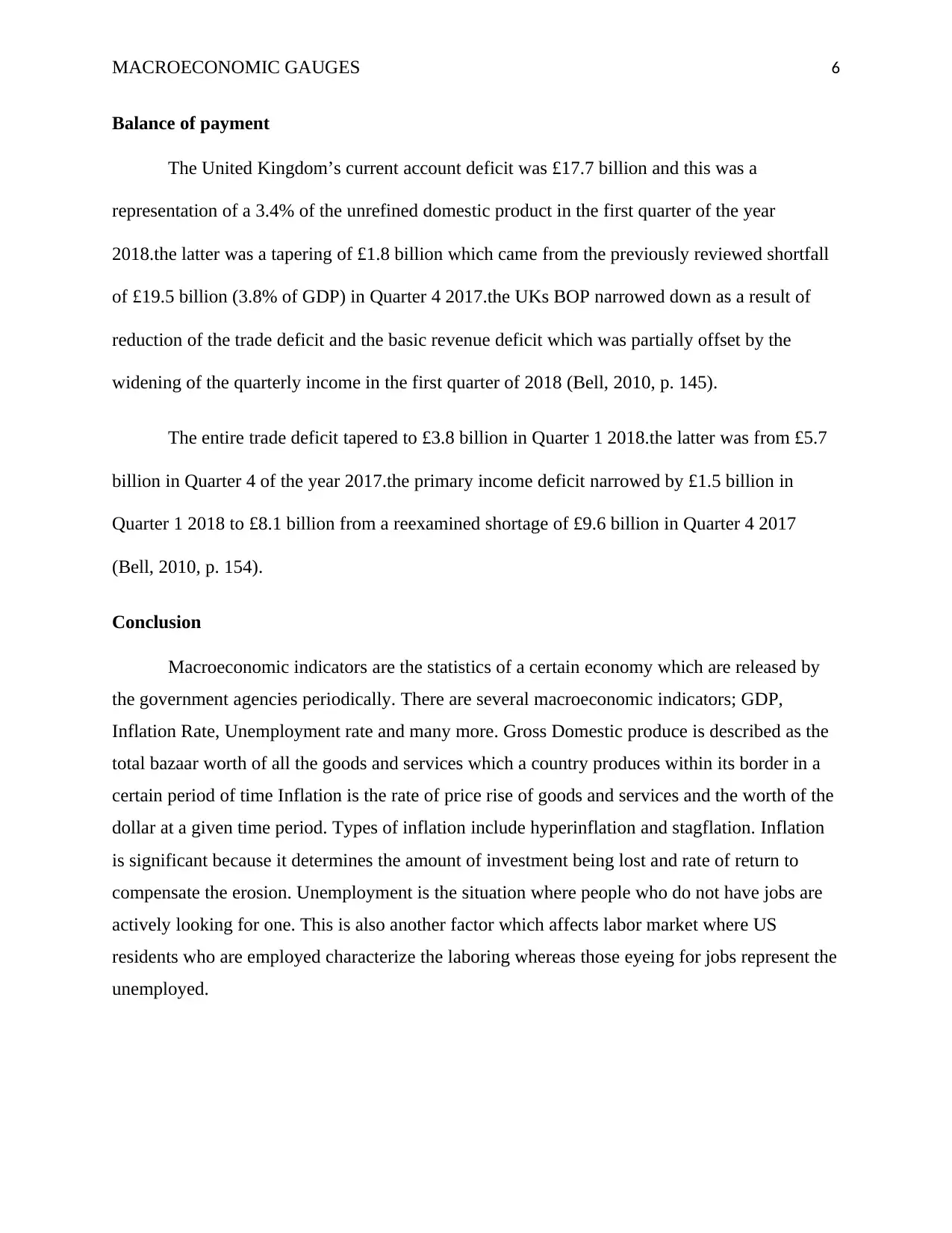
MACROECONOMIC GAUGES 6
Balance of payment
The United Kingdom’s current account deficit was £17.7 billion and this was a
representation of a 3.4% of the unrefined domestic product in the first quarter of the year
2018.the latter was a tapering of £1.8 billion which came from the previously reviewed shortfall
of £19.5 billion (3.8% of GDP) in Quarter 4 2017.the UKs BOP narrowed down as a result of
reduction of the trade deficit and the basic revenue deficit which was partially offset by the
widening of the quarterly income in the first quarter of 2018 (Bell, 2010, p. 145).
The entire trade deficit tapered to £3.8 billion in Quarter 1 2018.the latter was from £5.7
billion in Quarter 4 of the year 2017.the primary income deficit narrowed by £1.5 billion in
Quarter 1 2018 to £8.1 billion from a reexamined shortage of £9.6 billion in Quarter 4 2017
(Bell, 2010, p. 154).
Conclusion
Macroeconomic indicators are the statistics of a certain economy which are released by
the government agencies periodically. There are several macroeconomic indicators; GDP,
Inflation Rate, Unemployment rate and many more. Gross Domestic produce is described as the
total bazaar worth of all the goods and services which a country produces within its border in a
certain period of time Inflation is the rate of price rise of goods and services and the worth of the
dollar at a given time period. Types of inflation include hyperinflation and stagflation. Inflation
is significant because it determines the amount of investment being lost and rate of return to
compensate the erosion. Unemployment is the situation where people who do not have jobs are
actively looking for one. This is also another factor which affects labor market where US
residents who are employed characterize the laboring whereas those eyeing for jobs represent the
unemployed.
Balance of payment
The United Kingdom’s current account deficit was £17.7 billion and this was a
representation of a 3.4% of the unrefined domestic product in the first quarter of the year
2018.the latter was a tapering of £1.8 billion which came from the previously reviewed shortfall
of £19.5 billion (3.8% of GDP) in Quarter 4 2017.the UKs BOP narrowed down as a result of
reduction of the trade deficit and the basic revenue deficit which was partially offset by the
widening of the quarterly income in the first quarter of 2018 (Bell, 2010, p. 145).
The entire trade deficit tapered to £3.8 billion in Quarter 1 2018.the latter was from £5.7
billion in Quarter 4 of the year 2017.the primary income deficit narrowed by £1.5 billion in
Quarter 1 2018 to £8.1 billion from a reexamined shortage of £9.6 billion in Quarter 4 2017
(Bell, 2010, p. 154).
Conclusion
Macroeconomic indicators are the statistics of a certain economy which are released by
the government agencies periodically. There are several macroeconomic indicators; GDP,
Inflation Rate, Unemployment rate and many more. Gross Domestic produce is described as the
total bazaar worth of all the goods and services which a country produces within its border in a
certain period of time Inflation is the rate of price rise of goods and services and the worth of the
dollar at a given time period. Types of inflation include hyperinflation and stagflation. Inflation
is significant because it determines the amount of investment being lost and rate of return to
compensate the erosion. Unemployment is the situation where people who do not have jobs are
actively looking for one. This is also another factor which affects labor market where US
residents who are employed characterize the laboring whereas those eyeing for jobs represent the
unemployed.
⊘ This is a preview!⊘
Do you want full access?
Subscribe today to unlock all pages.

Trusted by 1+ million students worldwide
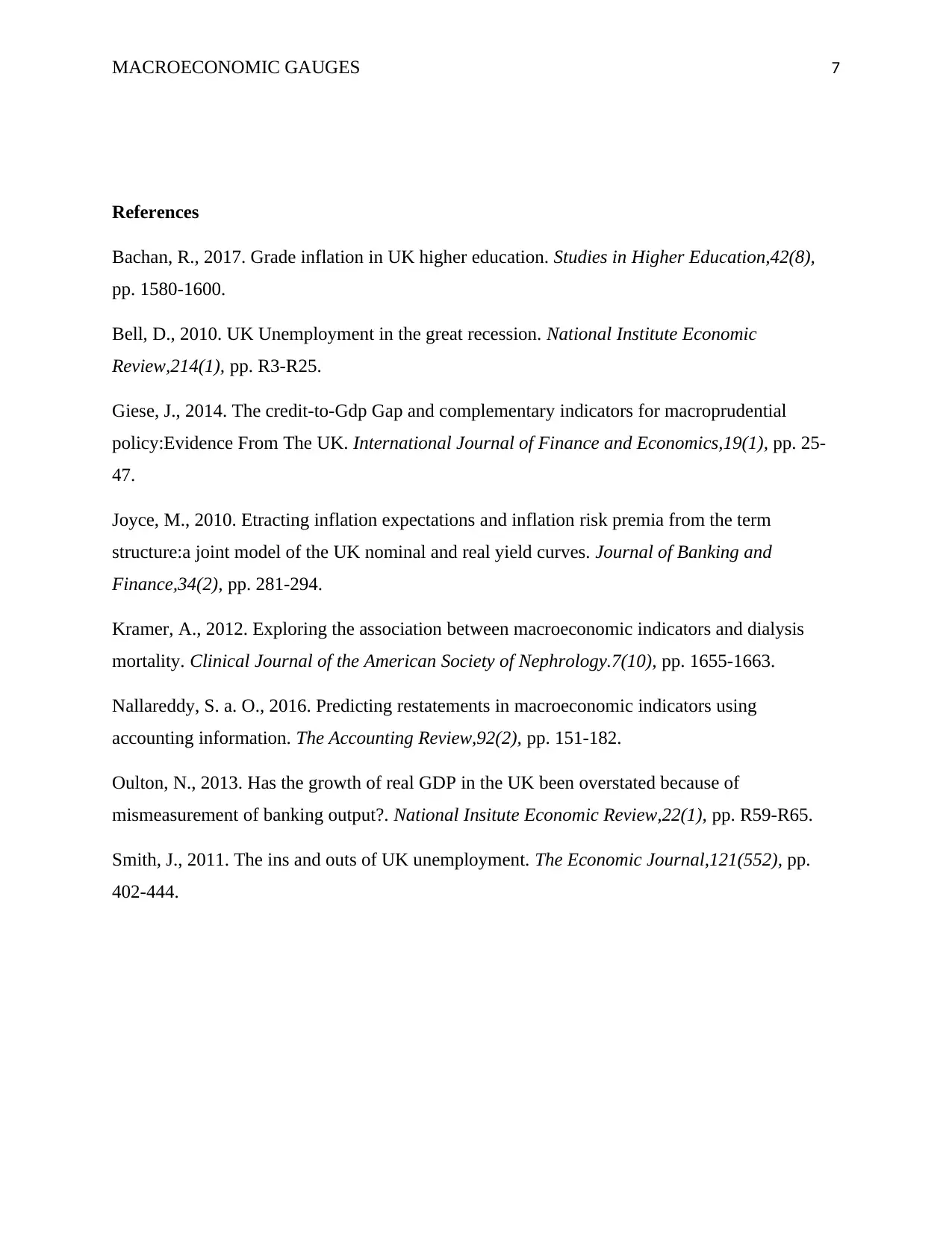
MACROECONOMIC GAUGES 7
References
Bachan, R., 2017. Grade inflation in UK higher education. Studies in Higher Education,42(8),
pp. 1580-1600.
Bell, D., 2010. UK Unemployment in the great recession. National Institute Economic
Review,214(1), pp. R3-R25.
Giese, J., 2014. The credit-to-Gdp Gap and complementary indicators for macroprudential
policy:Evidence From The UK. International Journal of Finance and Economics,19(1), pp. 25-
47.
Joyce, M., 2010. Etracting inflation expectations and inflation risk premia from the term
structure:a joint model of the UK nominal and real yield curves. Journal of Banking and
Finance,34(2), pp. 281-294.
Kramer, A., 2012. Exploring the association between macroeconomic indicators and dialysis
mortality. Clinical Journal of the American Society of Nephrology.7(10), pp. 1655-1663.
Nallareddy, S. a. O., 2016. Predicting restatements in macroeconomic indicators using
accounting information. The Accounting Review,92(2), pp. 151-182.
Oulton, N., 2013. Has the growth of real GDP in the UK been overstated because of
mismeasurement of banking output?. National Insitute Economic Review,22(1), pp. R59-R65.
Smith, J., 2011. The ins and outs of UK unemployment. The Economic Journal,121(552), pp.
402-444.
References
Bachan, R., 2017. Grade inflation in UK higher education. Studies in Higher Education,42(8),
pp. 1580-1600.
Bell, D., 2010. UK Unemployment in the great recession. National Institute Economic
Review,214(1), pp. R3-R25.
Giese, J., 2014. The credit-to-Gdp Gap and complementary indicators for macroprudential
policy:Evidence From The UK. International Journal of Finance and Economics,19(1), pp. 25-
47.
Joyce, M., 2010. Etracting inflation expectations and inflation risk premia from the term
structure:a joint model of the UK nominal and real yield curves. Journal of Banking and
Finance,34(2), pp. 281-294.
Kramer, A., 2012. Exploring the association between macroeconomic indicators and dialysis
mortality. Clinical Journal of the American Society of Nephrology.7(10), pp. 1655-1663.
Nallareddy, S. a. O., 2016. Predicting restatements in macroeconomic indicators using
accounting information. The Accounting Review,92(2), pp. 151-182.
Oulton, N., 2013. Has the growth of real GDP in the UK been overstated because of
mismeasurement of banking output?. National Insitute Economic Review,22(1), pp. R59-R65.
Smith, J., 2011. The ins and outs of UK unemployment. The Economic Journal,121(552), pp.
402-444.
Paraphrase This Document
Need a fresh take? Get an instant paraphrase of this document with our AI Paraphraser

MACROECONOMIC GAUGES 8
1 out of 8
Related Documents
Your All-in-One AI-Powered Toolkit for Academic Success.
+13062052269
info@desklib.com
Available 24*7 on WhatsApp / Email
![[object Object]](/_next/static/media/star-bottom.7253800d.svg)
Unlock your academic potential
Copyright © 2020–2025 A2Z Services. All Rights Reserved. Developed and managed by ZUCOL.





